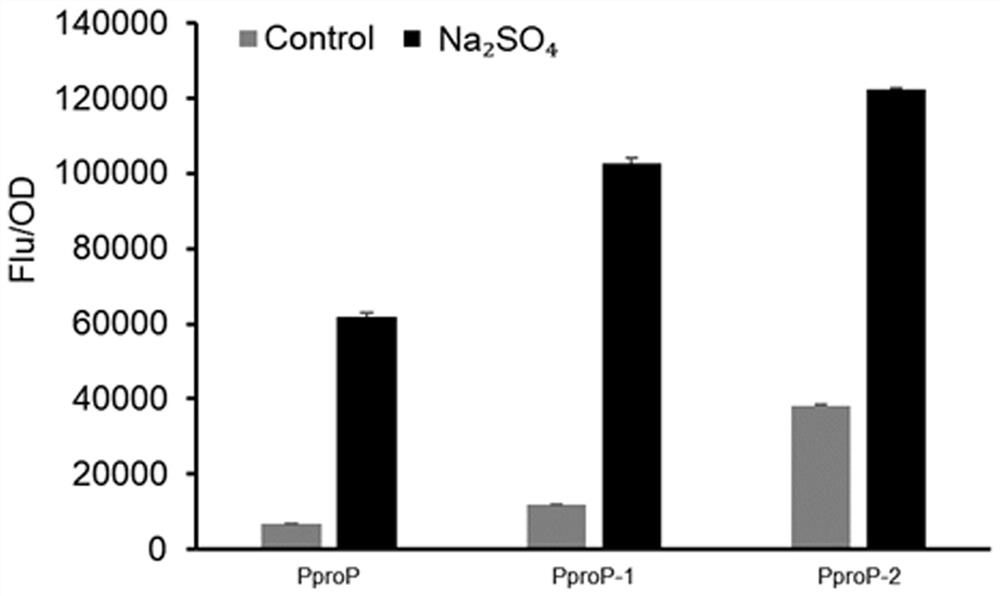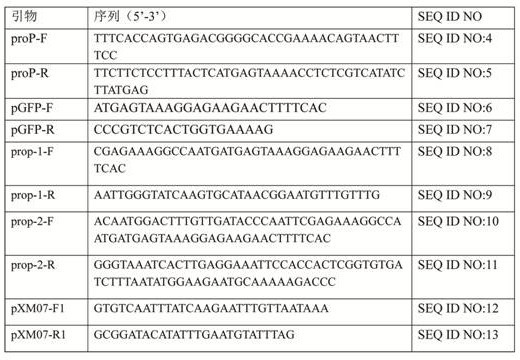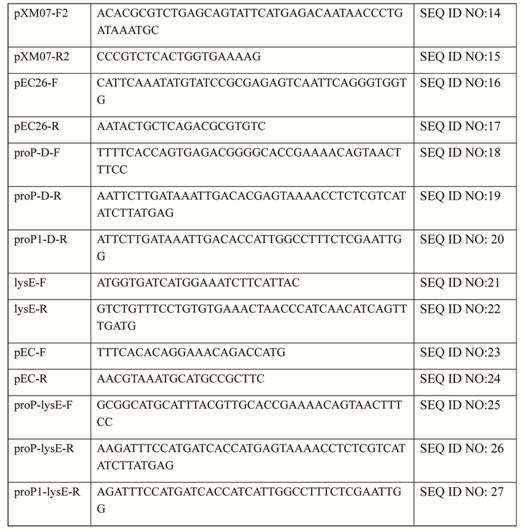Mutated hypertonic inducible promoter PproP and application thereof
A promoter and activity technology, applied in the field of genetic engineering and molecular biology, can solve the problem of bacterial strain toxicity
- Summary
- Abstract
- Description
- Claims
- Application Information
AI Technical Summary
Problems solved by technology
Method used
Image
Examples
Embodiment 1
[0113] Example 1. Contains endogenous proP Plasmid construction of gene promoter sequence
[0114] ProP is a proline uptake protein, which is induced to express under hyperosmotic conditions, and enhances the strain's tolerance to hyperosmotic environments by increasing the uptake of compatible substance proline. It has been reported in the literature that the expression of ProP will be significantly up-regulated under hyperosmotic conditions, indicating that the promoter of this gene may also be a hyperosmotic-inducible promoter (Franzel, B., et al., Adaptation of Corynebacterium glutamicum to salt-stress conditions, Proteomics, 2010, 10(3): 445–457.). According to the Corynebacterium glutamicum published by NCBI ( Corynebacterium glutamicum ) genome sequence of ATCC 13032 (NC_003450.3), and designed primers proP-F (SEQ ID NO: 4) and proP-R (SEQ ID NO: 5). Using the ATCC 13032 genome as a template, amplified by PCR with proP The promoter of the gene (P proP ) seque...
Embodiment 2
[0115] Example 2. High salt pair proP Induction of gene promoters
[0116] The above-mentioned strains with different promoter recombinant vectors were inoculated into TSB medium containing 5 μg / mL chloramphenicol, and cultured overnight at 30°C and 220 r / min. Among them, the composition of TSB liquid medium is (g / L): glucose, 5 g / L; yeast powder, 5 g / L; soybean peptone, 9 g / L; urea, 3 g / L; succinic acid, 0.5 g / L L; K 2 HPO 4 •3H 2 O, 1 g / L; MgSO 4 •7H 2 O, 0.1g / L; Biotin, 0.01 mg / L; Vitamin B1, 0.1 mg / L; MOPS, 20 g / L. Transfer with or without 0.6 M Na according to the initial OD 0.5 2 SO 4 CGXIIY medium, the culture system is 1 mL of 24-well plate, 30°C, 800 r / min for 18 h, and then detect the GFP fluorescence intensity and OD of different strains 600 , using the fluorescence intensity per unit cell (subtracting the fluorescence intensity per unit cell of the control strain under the same conditions) to characterize the relative intensities of different promoters un...
Embodiment 3
[0117] Example 3. proP Promoter modification and characterization plasmid construction
[0118]In order to further improve the starting strength and retain its higher high-salt-induced activity, the present invention, under the condition of retaining the possible regulatory regions, respectively, the 5'-UTR and the core regions of the -35 and -10 regions of the promoter and the 5 '-UTR undergoes sequence transformation and replacement to obtain P proP-1 (SEQ ID NO: 2) and P proP-2 (SEQ ID NO: 3) Two mutant promoters.
[0119] to pXM-P proP - gfp As a template, use primers proP-1-F (SEQ ID NO: 8) and proP-1-R (SEQ ID NO: 9) to amplify by PCR to replace proP In the 5'-UTR region behind the promoter, after recovering the above PCR fragment, use T4 PNK to phosphorylate the vector fragment, and construct pXM-P by self-circularization proP-1 - gfp . At the same time, with pXM-P proP - gfp As a template, using primers proP-2-F (SEQ ID NO: 10) and proP-2-R (SEQ ID NO: 1...
PUM
 Login to View More
Login to View More Abstract
Description
Claims
Application Information
 Login to View More
Login to View More - Generate Ideas
- Intellectual Property
- Life Sciences
- Materials
- Tech Scout
- Unparalleled Data Quality
- Higher Quality Content
- 60% Fewer Hallucinations
Browse by: Latest US Patents, China's latest patents, Technical Efficacy Thesaurus, Application Domain, Technology Topic, Popular Technical Reports.
© 2025 PatSnap. All rights reserved.Legal|Privacy policy|Modern Slavery Act Transparency Statement|Sitemap|About US| Contact US: help@patsnap.com



